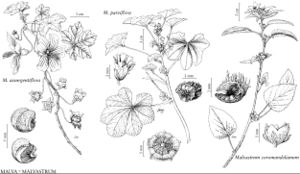Malvastrum
Mem. Amer. Acad. Arts, n. s. 4: 21. 1849.
| Taxon | Illustrator ⠉ | |
|---|---|---|
 | Malva assurgentiflora Malva parviflora Malvastrum coromandelianum | Linny Heagy Linny Heagy Linny Heagy |
Herbs, annual or perennial, or subshrubs, hairy, hairs closely appressed or tufted, sometimes pustular-based, (2–) 4–10 [–12] -rayed, stellate, sometimes bilateral, infrequently sublepidote or simple. Stems erect or ascending to decumbent. Leaves: stipules persistent [deciduous], lanceolate to linear [wide-ovate], usually subfalcate or falcate; blade wide-ovate to lanceolate, unlobed or sometimes obscurely 3-lobed, base rounded, slightly cordate, nearly truncate, to cuneate, margins crenate-dentate to dentate-serrate or denticulate. Inflorescences axillary solitary flowers, terminal racemes or spikes in distal 1/2 of plant; involucel present, bractlets persistent, 3, distinct, free or adnate basally to calyx. Flowers: calyx not inflated (slightly so in M. hispidum), somewhat accrescent, lobes 3–5-ribbed, deltate to narrowly triangular; corolla campanulate to widespreading, yellow to yellow-orange; staminal column included; ovary (5–) 8–18-carpellate; ovules 1 per cell; style 5–18-branched (equal in number to locules); stigmas capitate. Fruits schizocarps, erect, not inflated, oblate-discoid, usually depressed in center, somewhat indurate at maturity; mericarps (5–) 8–18, drying tan or brown, without dorsal spurs or with 1–3 apical (dorsal) spurs (mucros or cusps) 0.1–2.3 mm, sparsely to densely hairy, rarely glabrous, indehiscent or rarely dehiscent (in M. hispidum). Seeds 1 per mericarp, glabrous. x = 6.
Distribution
United States, Mexico, West Indies, Central America, South America, ne Australia
Discussion
Two or three species of Malvastrum have been widely introduced worldwide in tropical and warm-temperate regions; none is usually cultivated; several are considered to be quite weedy. At least one species (M. coromandelianum) has some medicinal use.
Species 15 (6 in the flora).
Selected References
None.
Lower Taxa
Key
| 1 | Mericarps unornamented or with 1 small apical mucro/cusp to 0.2 mm | > 2 |
| 1 | Mericarps with 1–3 apical cusps 0.1–2.3 mm | > 4 |
| 2 | Mericarps dehiscent, separating into 2 valves, edges of fruit rounded, mucro/cusp absent; inflorescences axillary solitary flowers; leaf blades lanceolate to linear-lanceolate, at least 3 times longer than wide; temperate c United States. | Malvastrum hispidum |
| 2 | Mericarps indehiscent, not separating into valves, edges of fruit angled, minute mucro/cusp usually present; inflorescences dense, terminal spikes, sometimes axillary solitary flowers below spikes; leaf blades ovate-lanceolate to ovate, sometimes narrower toward branch tips, usually 1–2 times longer than wide; warm-temperate to subtropical areas | > 3 |
| 3 | Leaves and stems with usually dense, 5–12-rayed, often tufted, stellate hairs; inflorescences dense terminal spikes 3–10 cm. | Malvastrum americanum |
| 3 | Leaves and stems with sparse, 3–6-rayed, appressed, bilateral and stellate hairs; inflorescences solitary flowers, axillary or congested or loose terminal spikes 1–2 cm. | Malvastrum corchorifolium |
| 4 | Mericarps 2-cusped, cusps conspicuous, distal (pointing away from fruit axis); stems erect, branched usually in distal 1/2; stem hairs not lepidote, 4–8-rayed, radially symmetric; filament tubes puberulent. | Malvastrum bicuspidatum |
| 4 | Mericarps 3-cusped, cusps conspicuous or minute, 1 halfway between proximal and distal ends of top surface, 2 distal; stems erect or ascending to decumbent, branched in proximal 1/2; stem hairs sublepidote and 6–10-rayed, or appressed and 2–4-rayed, stellate hairs sometimes mixed with simple hairs, 4-rayed hairs distinctly bilateral; filament tubes puberulent or glabrous | > 5 |
| 5 | Mericarp mucros/cusps 0.1–0.4 mm; 2-fid floral bracts usually present; filament tubes sparsely puberulent. | Malvastrum corchorifolium |
| 5 | Mericarp mucros/cusps 0.5–2.3 mm; 2-fid floral bracts absent; filament tubes glabrous | > 6 |
| 6 | Stem hairs sublepidote (stellate-lepidote), 6–10-rayed; mericarps with 1 prominent medial-apical cusp 1.5–2.3 mm and 2 contiguous, flattened, obtuse cusps 1 mm at distal margins. | Malvastrum aurantiacum |
| 6 | Stem hairs not sublepidote, 2–4-rayed, bilateral hairs; mericarps with 1 prominent medial-apical cusp 1–2 mm and 2 divergent distal-apical cusps 0.3–1 mm. | Malvastrum coromandelianum |